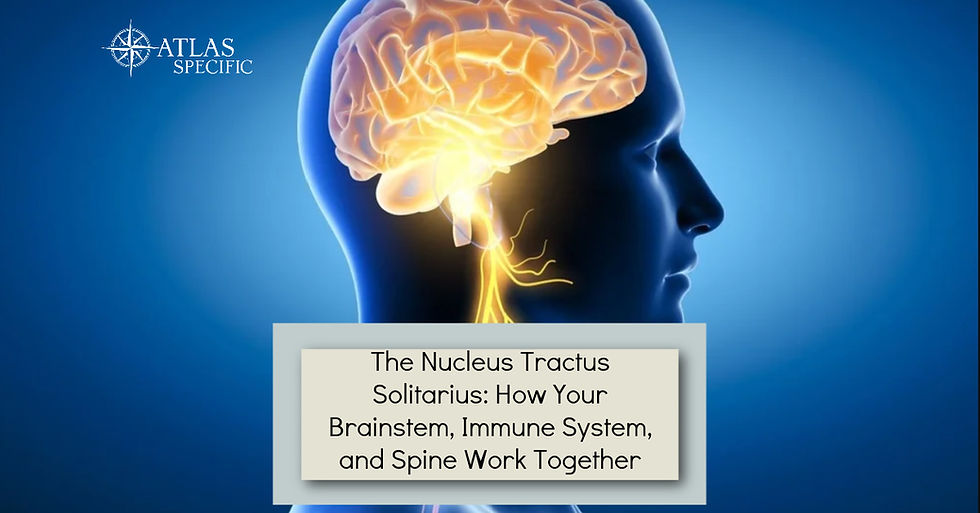The Nucleus Tractus Solitarius: How Your Brainstem, Immune System, and Spine Work Together
- Connie Byers

- Aug 28
- 4 min read

When you think of chiropractic care, chances are you picture the spine, muscles, and joints. But did you know that the very top of your spine, the atlas (C1) and axis (C2) vertebrae, play a vital role in protecting your brainstem and even influencing your immune system?
At the heart of this connection is a small but powerful cluster of neurons in the brainstem called the nucleus tractus solitarius (NTS). While it may sound complicated, the NTS is one of your body’s quiet control centers, working around the clock to regulate breathing, heart rate, digestion, and even inflammation. Let’s explore what it does, why it matters, and how precise upper cervical chiropractic care can support this essential system.
What Is the Nucleus Tractus Solitarius (NTS)?
The NTS lives in the lower brainstem, inside the medulla oblongata, which acts as the first relay and integration center for sensory information from the body. Think of it as a switchboard operator: it receives constant updates from sensors all over the body and helps regulate the automatic functions that keep you alive. Some of the signals it processes include:
Blood pressure from baroreceptors in your arteries
Oxygen and carbon dioxide levels from chemoreceptors
Organ function messages from the heart, lungs, and digestive system via the vagus nerve
Sensory input from muscles and joints, especially those in the upper cervical spine
Once the NTS gathers this information, it coordinates vital reflexes such as breathing rhythm, swallowing, heart rate, and blood pressure, all without you ever having to think about it.
How the Upper Cervical Spine Talks to the NTS
The atlas (C1) and axis (C2) vertebrae are unlike any others in your spine. Their unique shape allows your head to move freely, but it also makes them more vulnerable to misalignment. Packed with specialized sensors called mechanoreceptors, these vertebrae constantly send signals about movement, balance, and tension to your brainstem. Here’s why proper alignment in this region of the spine matters:
When your upper cervical spine is balanced, the NTS receives clear, consistent messages. This helps your brainstem regulate critical functions like blood pressure, breathing, and posture.
When misaligned, the signals can become distorted or excessive. This can confuse the brainstem and throw off your body’s natural balance, leading to problems with stress response, sleep, digestion, or circulation.
For patients, this might manifest as headaches, dizziness, poor sleep, or chronic tension that doesn’t seem to resolve.
The NTS and Your Immune System
The NTS does more than regulate your heart and lungs; it also plays a role in immune balance. Through its connection with the vagus nerve and other brainstem pathways, the NTS helps communicate with your body’s first responder cells, known as macrophages. Macrophages are part of your innate immune system, always on duty to protect you. They:
Patrol tissues for bacteria, viruses, or fungi
Clear away damaged cells and debris
Release chemical signals to coordinate inflammation
Recruit other immune cells to help with defense
Trigger the adaptive immune system for longer-term protection
The NTS helps regulate how active macrophages are, shifting your body toward defense when needed or calming inflammation once the threat has passed. When upper cervical misalignments interfere with brainstem communication, this balance can be disrupted, leaving your body less resilient over time.
Why This Connection Matters
Research is still growing, but the anatomy is clear: your upper cervical spine directly influences brainstem health, which in turn impacts your immune system. Patients under upper cervical care often report improved energy, clearer thinking, better sleep, and greater resilience, benefits that likely reflect healthier brain-body communication through hubs like the NTS.
For many, it’s the missing piece: rather than simply treating symptoms with medications, upper cervical chiropractic addresses the root cause by restoring alignment and allowing the nervous system to function as it was designed.
How Upper Cervical Care Supports the NTS
At Atlas Specific, your trusted Durango Chiropractor, we focus exclusively on precise, gentle corrections to the upper cervical spine. These adjustments are customized using detailed imaging and analysis so that your brainstem — and the NTS within it — can receive clear, accurate input from the body.
When alignment is restored, communication between the spine, brainstem, and immune system improves. That means better regulation of blood pressure, smoother breathing rhythms, more restful sleep, and a nervous system that can support immune balance naturally.
Supporting Your Health From the Top Down
Your spine is more than a structure. It’s the lifeline between your brain and body. At its core lies the brainstem, where the NTS works tirelessly to keep your body balanced, resilient, and functional. Protecting this vital hub with upper cervical chiropractic care may be one of the most powerful steps you can take toward long-term health.
If you’re ready to explore how upper cervical care can support your nervous and immune systems, click the link below to schedule a consultation today with Dr. Tim and Dr. Danielle at Atlas Specific, give us a call at 970.259.6803, or visit our Durango office.
Atlas Specific: The Durango Chiropractor who helps your body heal from the inside out.
Notice of Disclaimer:
We are doctors of upper cervical chiropractic, but we are NOT necessarily YOUR doctors. All content and information on this website is for informational and educational purposes only, does not constitute medical advice, and reading or interacting with this site does not establish any form of patient-doctor relationship. Although we strive to provide accurate information, the information presented here is not intended as a substitute for any kind of professional advice, and you should not rely solely on this information. Always consult a professional in your particular area of need before making medical decisions.







Comments